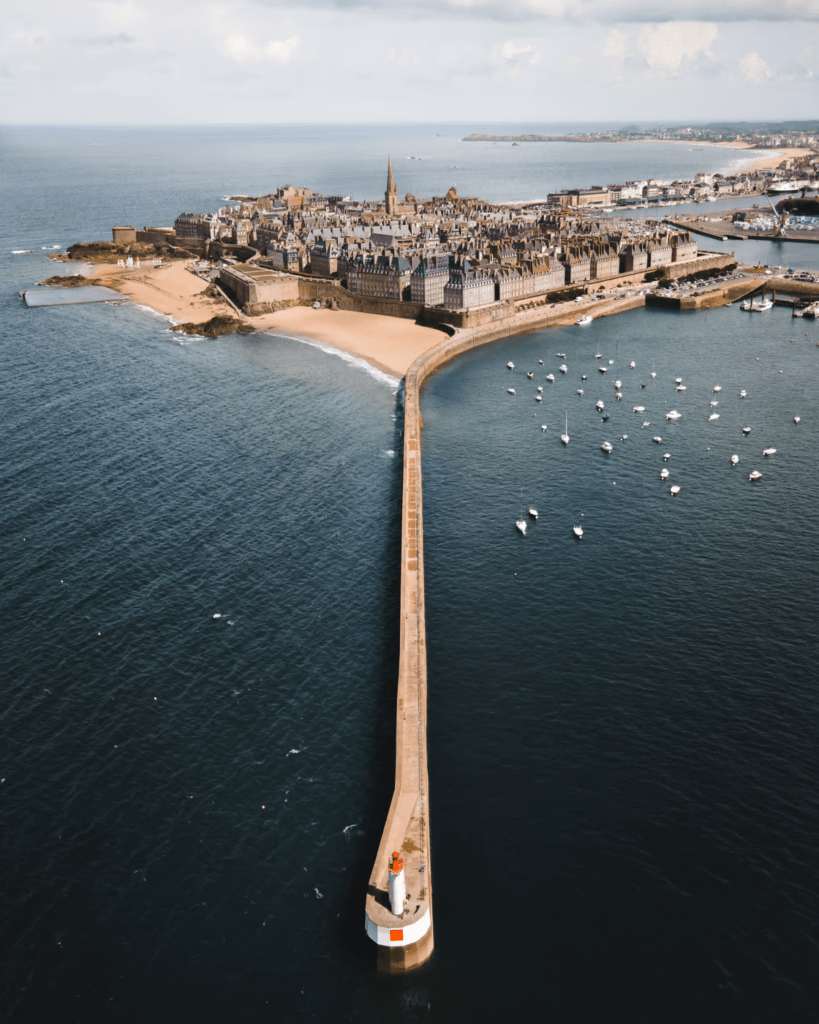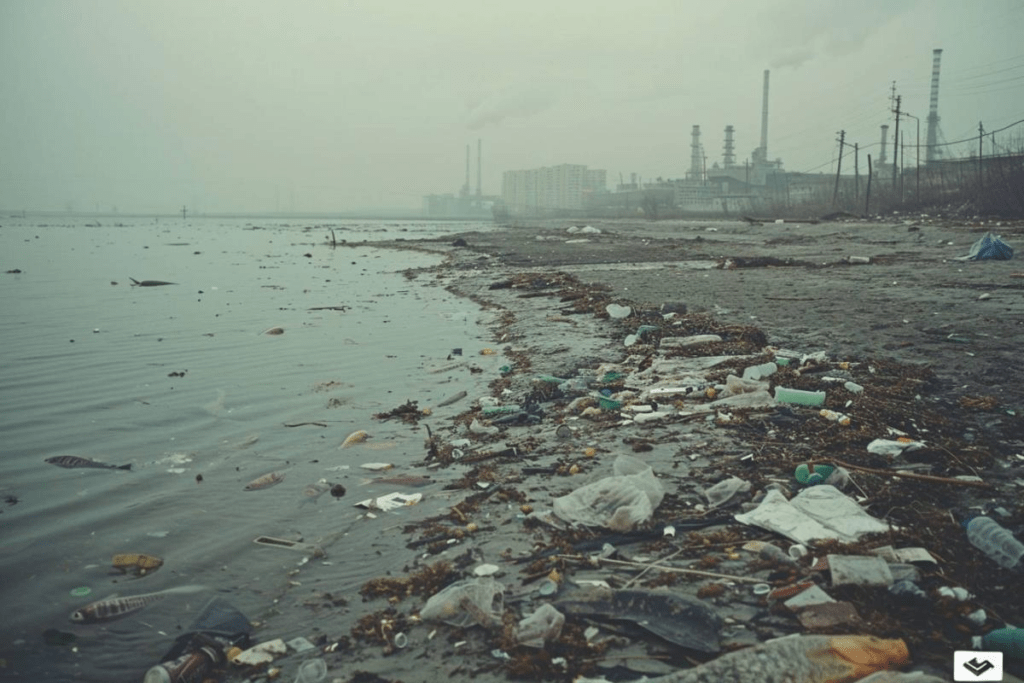Brittany is famous for its picturesque coastline, where dramatic cliffs meet the rolling waves of the Atlantic. But among the jewels of its shores lies a tragic paradox—Saint-Michel-en-Grève, a beach that once drew visitors for its stunning natural beauty, is now overwhelmed by pollution. The sprawling beach, located on the Bay of Lannion in the Côtes-d’Armor, has become a somber emblem of environmental degradation.
A Beach in Crisis
The environmental crisis at Saint-Michel-en-Grève exemplifies the clash between natural beauty and human impact. While the beach’s sands stretch out, giving the illusion of serenity, the water quality tells a different story. Year after year, tests from regional authorities reveal increasingly dangerous levels of pollution, turning this coastal paradise into a toxic environment for both locals and tourists.

The Pollutants
The pollution at Saint-Michel-en-Grève is the result of a deadly combination of factors, contributing to what has been described as a “toxic cocktail” of contaminants. The three main pollutants are:
- Green Algae (Ulva Blooms): The green algae problem at Saint-Michel-en-Grève is the most visible manifestation of the pollution crisis. Fueled by nutrient runoff, particularly from nitrogen-rich fertilizers used in agriculture, these algal blooms flourish in warm waters. As they decompose, they release hazardous hydrogen sulfide gas, which can be deadly in confined spaces and harmful to humans and wildlife.
- Fecal Bacteria: Poor wastewater management and agricultural runoff also contribute to high levels of fecal bacteria in the water. Contaminated by human and animal waste, these bacteria pose serious health risks, particularly for swimmers who may suffer from gastrointestinal illnesses or skin infections after exposure.
- Microplastics: Perhaps less visible but no less dangerous, microplastics have steadily invaded the beach. These tiny plastic fragments, the byproduct of plastic degradation in the oceans, accumulate on the shore and in the water, affecting marine life and entering the food chain.
Causes of Pollution
The pollution crisis at Saint-Michel-en-Grève can largely be traced back to two primary factors: intensive agriculture and inadequate wastewater treatment.
- Agricultural Runoff: The surrounding region’s reliance on intensive farming practices—particularly the use of synthetic fertilizers—has led to excessive nutrient runoff. Nitrogen and phosphorous from fertilizers drain into the waterways, eventually finding their way to the sea, where they feed harmful algal blooms. These blooms block sunlight, deplete oxygen, and ultimately smother marine ecosystems.
- Inadequate Wastewater Infrastructure: A critical failure in wastewater management has also contributed to the degradation of water quality. Insufficient treatment of sewage allows bacteria and nutrients to enter the water system, further aggravating the environmental damage. This is compounded by occasional overflows from sewage systems during heavy rains, which flush untreated waste directly into the sea.

Consequences: Human and Ecological Impact
The pollution at Saint-Michel-en-Grève poses significant risks, not only to the environment but also to human health and the local economy.
- Human Health Risks: Swimmers are increasingly advised to avoid the water due to health risks associated with the beach’s pollution. Contact with the water can cause skin rashes, respiratory problems, and more serious infections, especially from fecal bacteria and toxic algae.
- Marine Life in Peril: The green algae problem has devastating effects on marine ecosystems. When algae die and decompose, they remove oxygen from the water, creating “dead zones” where few marine species can survive. The resulting collapse of fish populations and other marine organisms threatens biodiversity and disrupts the entire ecosystem.
- Economic Impact on Tourism: Saint-Michel-en-Grève was once a thriving destination for tourists, drawn to its beauty and the water sports opportunities. Now, the beach’s poor reputation has begun to hurt local tourism, leading to losses for the hospitality and recreational industries. As the pollution worsens, the local economy suffers, putting jobs and livelihoods at risk.
Toward Recovery: Solutions and Efforts
Addressing the pollution crisis at Saint-Michel-en-Grève requires a comprehensive approach, targeting the root causes of pollution and implementing both short- and long-term strategies to restore the health of the beach.
- Sustainable Agricultural Practices: Reducing nutrient runoff from farms is a critical first step. Adopting more sustainable farming methods—such as using fewer chemical fertilizers, planting buffer strips, and practicing crop rotation—can help reduce the flow of harmful nutrients into waterways.
- Upgrading Wastewater Treatment Systems: Local governments must invest in upgrading wastewater infrastructure to prevent untreated sewage from polluting the coastline. This includes improving treatment plants to better filter contaminants and ensuring that stormwater systems do not discharge waste directly into the sea during heavy rainfall.
- Regular Beach Cleanup Campaigns: In the short term, local communities and environmental groups can organize regular cleanup campaigns to remove litter, plastics, and algae from the beach. This can help mitigate some of the immediate damage while more permanent solutions are put into place.
- Education and Public Awareness: Engaging the public is essential in the fight to save Saint-Michel-en-Grève. Raising awareness about the dangers of pollution and the steps individuals can take to reduce their own environmental impact is a crucial component of long-term recovery. Public support can also encourage policymakers to take stronger action.
Broader Implications: A Global Challenge
While the situation at Saint-Michel-en-Grève is severe, it is far from unique. Coastal regions around the world are grappling with similar pollution issues, underscoring the need for global cooperation in the fight against marine pollution.
- Climate Change and Algal Blooms: As global temperatures rise, algae blooms are becoming more frequent and severe in many parts of the world. Warmer waters create an ideal breeding ground for these harmful blooms, exacerbating the problems of nutrient runoff.
- Economic Losses for Coastal Regions: Coastal areas that rely on tourism are particularly vulnerable to pollution-related economic downturns. The case of Saint-Michel-en-Grève is a stark reminder of how quickly environmental degradation can lead to economic losses for local communities.
- International Efforts for Marine Protection: Addressing coastal pollution requires a concerted global effort. International agreements, such as the United Nations’ Sustainable Development Goals (SDGs), emphasize the importance of protecting marine environments. Cooperation among nations is essential for reducing pollutants in oceans and protecting biodiversity.

A Call for Action
The story of Saint-Michel-en-Grève serves as a powerful reminder of the fragility of our natural environments and the urgent need for action. The pollution of this once-pristine beach is a warning signal for coastal regions everywhere: without significant changes to agricultural practices, wastewater treatment, and public awareness, beaches like Saint-Michel-en-Grève may disappear under the weight of pollution.
But there is hope. With sustained efforts from local governments, farmers, environmental organizations, and citizens, the beach can be restored. The road to recovery will require time, commitment, and innovation, but it is a necessary journey to safeguard both the environment and the local communities that depend on it.
Related Content
- brittany: the village of saint-michel-en-grève by élisée maclet
- Brittany, the best-kept secret of France
- Saint-Michel-en-Grève – Bretagne Pink Granit Coast Tourism
- Men Women Water Shoes,Swimming Shoes Solid Color Summer Aqua Beach Shoes, Socks Seaside Sneaker Slippers
- Mandala Flower Tote Bags Women Eco Linen Reusable Shopping Bag Floral Print Handbags For Lady Traveling Beach
- Beach Rules Hanging Sign
- Extended Summer in Japan: High Temperatures Expected Through September and October
- Ponant Charts a Course for Carbon-Neutral Cruising by 2030
- Water-Powered Car Revolution: A Game-Changer for the Auto Industry and the Environment
- How Climate Change Will Disrupt Water Resources in France
- 10pcs Waterproof and Sweatproof Flag Tattoo Stickers, Rectangular Shape, Ideal for Sports Fans, World Championships, Olympic Games, Festival Events, Parties, and Face Decoration – Makeup Category
- 1pc 600ml/20oz BPA Free Eco Friendly Portable Bottle Large Capacity Plastic Cup, Portable Plastic Drink Bottle Leak-proof Water Bottle Sport Plastic Drinking Water Cup With Lid School Sport Cup For Plastic Frosted Creative Water Bottles
- Men Women Water Shoes,Swimming Shoes Solid Color Summer Aqua Beach Shoes, Socks Seaside Sneaker Slippers – Micro2media
- 1pc 100% Bamboo Fiber Waterproof Mattress Protector (250gsm), Cooling And Breathable Knitted Mattress Pad Cover, 3D Air Bed Cover For Cozy Sleep


